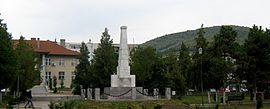|
Babadag
Babadag (Romanian pronunciation: [babaˈdaɡ] ⓘ; Turkish: Babadağ, lit. "Father Mountain"), formerly known as Babatag,[3] is a town in Tulcea County, Romania, located on a small lake formed by the river Taița, in the densely wooded highlands of Northern Dobruja. One of the several tombs of Sari Saltik is found in town. The Babadag Lake is divided only by a strip of marshland from Razim Lake, a broad landlocked sheet of water spilling into the Black Sea. History The name of Babadag is connected with 13th century dervish Baba Sari Saltik, who is said to have led a number of Turkomans to Dobruja and to have settled them in this area. The town was first mentioned by Ibn Battuta under the name Baba Saltuk, as the furthermost outpost of the "Turks" (i.e., the Golden Horde).[4] The town was conquered by Bayezid I, sultan of the Ottoman Empire, in his 1393 Danubian campaign. The construction of a fortress was begun here in 1633 during the reign of Murad IV, but by 1650 only the fortress's foundation walls and towers were standing. In the 17th century, it occasionally served as the winter headquarters for the Grand Vizier of the Ottoman Empire during their wars with Russia.[3] The town's location near to the Black Sea made it a target for the Russian navy, the town was bombed by the Russians in 1854 during the Crimean War.[3] In the mid-19th century, Babadag formed part of the region (sanjak) of Silistra within the "Bulgarian Government" (Danube Vilayet).[3] Following the 1877–1878 war between the Ottoman and Russian empires, Babadag became part of independent Romania. Military training facilityAt Babadag, the Romanian Army operates a military training facility. With a total surface area of 2,700 ha (27 km2; 10 sq mi), the area can accommodate live-fire exercises for infantry and tanks at company level as well as artillery subunits.[5] In 2008, United States Army forces started to train at Babadag as part of Romania's integration into NATO.[6] In 2022, units of the 101st Airborne Division (that has returned to Europe for the first time since the end World War II) deployed to the Mihail Kogălniceanu Air Base have been training at the Babadag base, near the border with Ukraine.[7] The facility is subordinated to the Cincu Training Center.[8] Demographics
In 1900, Babadag's population was 3,500.[9] The 2011 census counted 8,940 inhabitants; the population distribution was: 6,267 Romanians (77.64%), 1,248 Horahane Roma (15.46%),[10] 420 Turks (5.2%), 37 Lipovans (0.45%), and 98 others. 84.8% were Romanian Orthodox and 14.2% Muslim. At the 2021 census, Babadag had a population of 9,213; of those, 66.36% were Romanians, 16.23% Roma, and 2.42% Turks.[11] EconomyBefore the First World War, Babadag served as the market for wool and mutton from the Dobruja.[9] Natives
Gallery
Notes
References
External linksWikimedia Commons has media related to Babadag. |
|||||||||||||||||||||||||||||||||||||||||||||||||||||||||||||||||||||||||||||||||||
Portal di Ensiklopedia Dunia




![The Gazi Ali Pasha Mosque [ro]](http://upload.wikimedia.org/wikipedia/commons/thumb/1/1e/RO_TL_Geamia_Ali-Gazi_Pa%C8%99a_din_Babadag.JPG/180px-RO_TL_Geamia_Ali-Gazi_Pa%C8%99a_din_Babadag.JPG)



